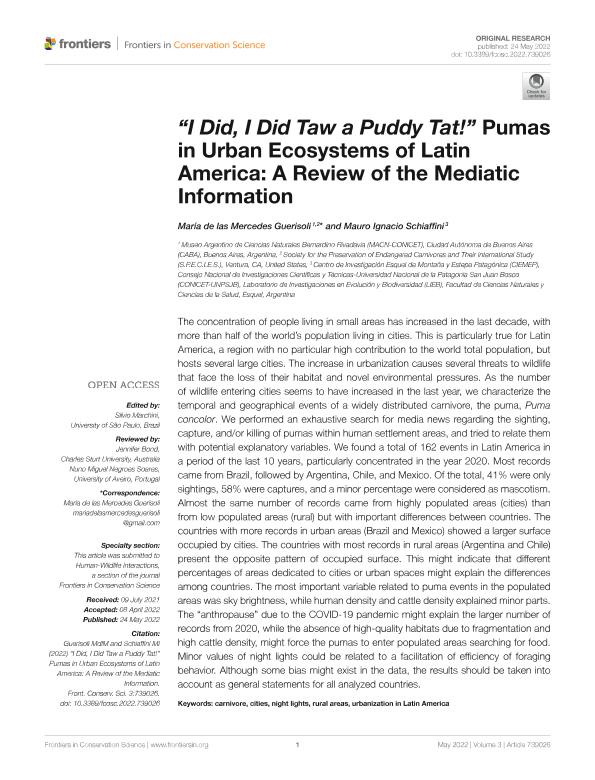Mostrar el registro sencillo del ítem
dc.contributor.author
Guerisoli, Maria de Las Mercedes

dc.contributor.author
Schiaffini, Mauro Ignacio

dc.date.available
2023-08-30T19:54:54Z
dc.date.issued
2022-05
dc.identifier.citation
Guerisoli, Maria de Las Mercedes; Schiaffini, Mauro Ignacio; "I did, I did taw a puddy tat!" Pumas in urban ecosystems of Latin America: a review of the mediatic information; Frontiers Media; Frontiers in Conservation Science; 3; 5-2022; 1-14
dc.identifier.uri
http://hdl.handle.net/11336/210005
dc.description.abstract
The concentration of people living in small areas has increased in the last decade, with more than half of the world's population living in cities. This is particularly true for Latin America, a region with no particular high contribution to the world total population, but hosts several large cities. The increase in urbanization causes several threats to wildlife that face the loss of their habitat and novel environmental pressures. As the number of wildlife entering cities seems to have increased in the last year, we characterize the temporal and geographical events of a widely distributed carnivore, the puma, Puma concolor. We performed an exhaustive search for media news regarding the sighting, capture, and/or killing of pumas within human settlement areas, and tried to relate them with potential explanatory variables. We found a total of 162 events in Latin America in a period of the last 10 years, particularly concentrated in the year 2020. Most records came from Brazil, followed by Argentina, Chile, and Mexico. Of the total, 41% were only sightings, 58% were captures, and a minor percentage were considered as mascotism. Almost the same number of records came from highly populated areas (cities) than from low populated areas (rural) but with important differences between countries. The countries with more records in urban areas (Brazil and Mexico) showed a larger surface occupied by cities. The countries with most records in rural areas (Argentina and Chile) present the opposite pattern of occupied surface. This might indicate that different percentages of areas dedicated to cities or urban spaces might explain the differences among countries. The most important variable related to puma events in the populated areas was sky brightness, while human density and cattle density explained minor parts. The “anthropause” due to the COVID-19 pandemic might explain the larger number of records from 2020, while the absence of high-quality habitats due to fragmentation and high cattle density, might force the pumas to enter populated areas searching for food. Minor values of night lights could be related to a facilitation of efficiency of foraging behavior. Although some bias might exist in the data, the results should be taken into account as general statements for all analyzed countries.
dc.format
application/pdf
dc.language.iso
eng
dc.publisher
Frontiers Media

dc.rights
info:eu-repo/semantics/openAccess
dc.rights.uri
https://creativecommons.org/licenses/by/2.5/ar/
dc.subject
CARNIVORE
dc.subject
CITIES
dc.subject
NIGHT LIGHTS
dc.subject
RURAL AREAS
dc.subject
URBANIZATION IN LATIN AMERICA
dc.subject.classification
Ecología

dc.subject.classification
Ciencias Biológicas

dc.subject.classification
CIENCIAS NATURALES Y EXACTAS

dc.title
"I did, I did taw a puddy tat!" Pumas in urban ecosystems of Latin America: a review of the mediatic information
dc.type
info:eu-repo/semantics/article
dc.type
info:ar-repo/semantics/artículo
dc.type
info:eu-repo/semantics/publishedVersion
dc.date.updated
2023-06-29T10:18:04Z
dc.identifier.eissn
2673-611X
dc.journal.volume
3
dc.journal.pagination
1-14
dc.journal.pais
Suiza

dc.journal.ciudad
Lausana
dc.description.fil
Fil: Guerisoli, Maria de Las Mercedes. Consejo Nacional de Investigaciones Científicas y Técnicas. Oficina de Coordinación Administrativa Parque Centenario. Museo Argentino de Ciencias Naturales "Bernardino Rivadavia"; Argentina. Society For The Preservation Of Endangered Carnivores And Their International Ecological Study; Estados Unidos
dc.description.fil
Fil: Schiaffini, Mauro Ignacio. Consejo Nacional de Investigaciones Científicas y Técnicas. Centro Científico Tecnológico Conicet - Patagonia Norte. Centro de Investigación Esquel de Montaña y Estepa Patagónica. Universidad Nacional de la Patagonia "San Juan Bosco". Centro de Investigación Esquel de Montaña y Estepa Patagónica; Argentina. Universidad Nacional de la Patagonia "San Juan Bosco". Facultad de Ciencias Naturales - Sede Esquel. Laboratorio de Investigaciones en Evolución y Biodiversidad; Argentina
dc.journal.title
Frontiers in Conservation Science
dc.relation.alternativeid
info:eu-repo/semantics/altIdentifier/url/https://www.frontiersin.org/articles/10.3389/fcosc.2022.739026/full
dc.relation.alternativeid
info:eu-repo/semantics/altIdentifier/doi/https://doi.org/10.3389/fcosc.2022.739026
Archivos asociados
